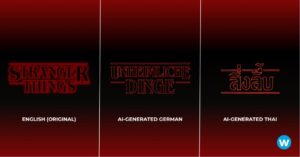AI In Title Treatments: Striking The Right Balance Between Speed And Quality
July 24, 2025

July 24, 2025
AI is already transforming user experience across streaming platforms. From personalized trailers to conversational search, it’s fast, scalable, and cost-efficient. The industry is racing to adopt it, and for good reason. The pressure to localize faster, reach more markets, and deliver seamless on-service experiences is real.
But here’s what’s not being said enough: Speed doesn’t always equal relevance. Scale doesn’t guarantee trust. And this is particularly true for title treatments.
They may seem like a small detail in the broader UX. But they’re not. A title treatment is a first impression, a key visual element that shapes how a viewer perceives content before they watch it.
For global audiences, a title treatment is more than just a translation. It’s a localized visual identity – typography, layout, and design, all adapted for different languages and markets. It’s often the first visual touchpoint a subscriber sees when they land on a title. If it looks off, poorly translated, misaligned, or culturally inconsistent, it sends the wrong signal before a single frame plays.
AI can absolutely support this process, but it can’t replace human context, especially when it comes to content creation. Because when AI generates title cards that are misaligned, mistranslated, or culturally tone-deaf, they damage credibility. The entire on-service experience starts to feel generic, untrustworthy, or – worse – careless.
Here’s what the data tells us: US subscribers are open to AI-generated trailers. In the UK, conversational search powered by AI is seen as a feature, not a flaw. But in France, 48% of people still view AI as a threat to creative production. And in Spain and China, new legislation now requires that any content created solely by AI must be clearly labelled or risk fines.
AI belongs in your UX toolkit. It enhances and improves on-service experiences. But if you’re thinking about using it exclusively as a replacement for human workflows that require human input, that’s a miss. Because without expert human oversight, AI doesn’t scale UX, it risks hindering it.
Speed matters, especially for creative operations managing global campaigns and launch deadlines. AI is a tempting solution on its own: fast, scalable, and consistent (mostly). But speed without oversight can lead to mistakes that slow things down further via revisions, rework, or audience backlash.
In the world of streaming, first impressions shape perception. And in creative localization, “good enough” isn’t good enough if it means undermining user trust the moment right before a viewer presses play.
On paper, AI might appear faster and cheaper than human-only or a human-AI blend. But zoom out, and a different picture emerges:
What looks like a shortcut can quickly become a detour. When precision and cultural nuance are essential, like in title treatment localization, missteps create friction, not efficiency.
Using ChatGPT 4.0, we recently tested an AI-generated title treatment for a globally recognized show.

The tool nearly nailed the German version. But the Thai version? Lines misaligned. Letters breaking through the frame. And a direct translation that rendered Stranger Things as Secret Things. The correct Thai title is สเตรนเจอร์ ธิงส์—a phonetic transliteration that’s widely recognized by viewers in Thailand.
In the world of streaming UX, these errors add up to launch delays, manual rework, frustrated creative teams, and an inconsistent viewer experience. In some cases, the time spent “iterating” the AI and correcting its mistakes outweighs the time it would’ve taken for a human designer to create it from scratch.
Human insight provides context, and without context, mistakes that seem minor slip through the cracks. So, the deeper challenge is: How do global creative teams keep up with go-to-market demands without compromising quality, cultural nuance, or first impressions?
AI, when applied with intent rather than a wholesale replacement, acts as a force multiplier. Automated tools can streamline repetitive, rules-based tasks, like safe-zone adjustments, contrast checks, or file versioning. It can also improve speed and ensure consistency across massive content sets.
In the right scenarios, these tools reduce human error, cut production cycles, and improve throughput. But their value depends on clearly defined boundaries. AI shouldn’t attempt to replicate creativity or cultural nuance it doesn’t yet understand.
The most effective workflows use automation to handle the mechanical, so human talent can focus on the meaningful.
AI performs best in environments where inputs are consistent, logic is linear, and outputs are easily validated. Think batch-processing metadata, formatting subtitle files, and background backfills.
But creative localization doesn’t follow neat patterns. It requires brand sensitivity, cultural fluency, and design instincts – factors that resist standardization. In these contexts, the goal isn’t just efficiency. It’s impact.
That’s where AI’s limits show. And that’s where over-automation begins to cost more than it saves. The most valuable question isn’t “Can this be automated?” It’s “Where does AI meaningfully enhance results without introducing risk?” The best creative systems are both fast and disciplined. They balance automation with judgment, and efficiency with experience.
AI isn’t a silver bullet, and it shouldn’t be treated as one. In high-impact areas like title treatments, where precision and perception matter, relying too heavily on AI can degrade both the output and the user experience.
That doesn’t mean automation has no place. It means its place must be strategic, not assumed. Brands leading in global creative execution aren’t chasing every AI tool. They’re building strategies around where those tools drive true value, striking the right balance and blending AI and people where they matter most. Because in creative production, fast only works if it’s also right.